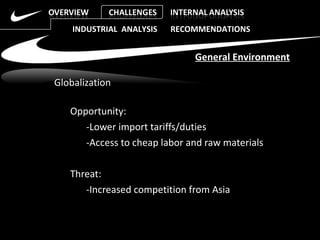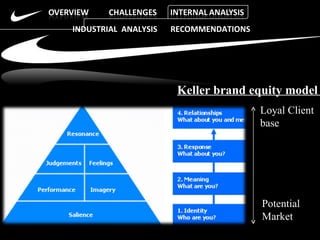Nike final
- 1. Presentation by: Rahul Tiwari (54) Aditya Gulshan (03) Jrituraj
- 3. Target Market Male and Female; 18 – 34 y.o. Positioning High performance shoes designed with hi-tech features Have many brands and products model for each type of consumers. Have high allocation of advertising budget for endorser contract, TVC, print ads, and sponsorship activities. Have top endorsers that are the champion in their sports areas.
- 4. BUILDING A GLOBAL BRAND INDUSTRIAL ANALYSIS RECOMMENDATIONS After making a mark in the US shoe industry, how Nike captured The European Market from the German duo giants: ADIDAS and PUMA The basic quest was how to best approach the EU market , and How should Nike's quest be different from that in US
- 5. Globalization Opportunity: -Lower import tariffs/duties -Access to cheap labor and raw materials Threat: -Increased competition from Asia INDUSTRIAL ANALYSIS RECOMMENDATIONS General Environment
- 6. INDUSTRIAL ANALYSIS RECOMMENDATIONS Keller brand equity model Potential Market Loyal Client base
- 7. INDUSTRIAL ANALYSIS RECOMMENDATIONS
- 8. INDUSTRIAL ANALYSIS RECOMMENDATIONS
- 9. INDUSTRIAL ANALYSIS RECOMMENDATIONS Bargaining to : Supplier High Buyer High Threat of: New Entrant Low Substitution Low Existing Competition Conclusion: Internal Rivalry High (Oligopoly) Five forces (Porter)
- 10. Bargaining Power of Suppliers: -- Tiger shoes which used to supply for Blue Ribbon (NIKE) demanding more control over its operations in 1971 -- Lack of finance available for US openings led Nike to sell the licensing rights to local distributors in Europe. -- Each Distributor focusing on its own country and after selling a number of other athletic shoe brands. Porter’s Five Forces Model INDUSTRIAL ANALYSIS RECOMMENDATIONS
- 11. Bargaining Power of Buyers: -Competitive products all compete on differentiation -Low switching costs -Women began to demand shoes with style, fashion, comfort and should be for women -Running replaced by aerobics and fitness -Basket ball shoes demanded performance unlike casual shoes -Each sport shoe separately defined as category , addressing the needs of the customers in each sport Porter’s Five Forces Model INDUSTRIAL ANALYSIS RECOMMENDATIONS
- 12. Threat of Substitute Products: -L K shoes a Romanian firm with shoes of questionable quality was a close substitute in the tennis range Porter’s Five Forces Model INDUSTRIAL ANALYSIS RECOMMENDATIONS Threat of Potential New Entrants: -Reebok made a batch of aerobic shoes with soft garment leather -For women product
- 13. Intensity of Rivalry between Firms in the Industry: -High competition in an Oligopoly (other leading firms include Adidas, Puma, Fila, New Balance) -Strong brand identity and product differentiation -Intensity of Rivalry is moderate Porter’s Five Forces Model INDUSTRIAL ANALYSIS RECOMMENDATIONS
- 14. Porter’s Five Forces Model INDUSTRIAL ANALYSIS RECOMMENDATIONS High Moderate Low Bargaining Power of Suppliers Bargaining Power of Buyers Threat of Substitutes Threat of New Entry Intensity of Rivalry Between Firms
- 15. INDUSTRIAL ANALYSIS RECOMMENDATIONS STORY EVENT 1962, BLUE RIBBON WAS STARTED. NEGLECTED SEGMENT OF ATHELETES WAS IDENTIFIED GERMAN PLAYERS ADIDAS AND PUMA IN THE PICTURE CONCEPT TO PROVIDE QUALITY RUNNING SHOES RECLAIMING MARKET FROM REEBOK SALIES SURPRESSED BY $2 BILLION AFTER US SET OF 5 EMPLOYEES WAS DISPATCHED TO EU
- 16. INDUSTRIAL ANALYSIS RECOMMENDATIONS Events Lack of financing available Distributors communicated its own interpretation ADIDAS/PUMA had together 75% of Market Share EU were slower to embrace sneakers or Off-court shoes. Fine leather shoes were preferred Fewer athlete shoes were required Nike restricted its production to primarily high-end ,high priced shoes.
- 17. INDUSTRIAL ANALYSIS RECOMMENDATIONS Events In 1980’s the most popular sports in EU were soccer, tracks and fields games and tennis 5 primary markets were targeted in EU i.e. Germany, France, England Italy, Spain EU’s found the brand intimidating, aggressive, unreachable and unattainable
- 18. Partnership / independent organization Benefits: -Knowledge -Credibility Drawbacks: -Control surrender: -Information leakage Alternatives INDUSTRIAL ANALYSIS RECOMMENDATIONS
- 19. Vertical Integration benefits: -Full control -More profits -Drawbacks -Very costly -Less flexible Alternatives INDUSTRIAL ANALYSIS RECOMMENDATIONS
- 20. Balanced scorecard Benefits: -Control -Competitive advantage Drawbacks: -Commitment INDUSTRIAL ANALYSIS RECOMMENDATIONS Alternatives
- 21. Balanced scorecard: -Competitive advantage -Less expensive -Preservation of control -Preservation of flexibility INDUSTRIAL ANALYSIS RECOMMENDATIONS Conclusion
- 22. Thank you






















